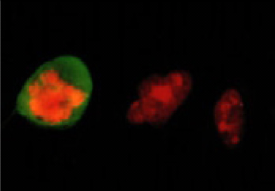Vimentin (VIM) pSer55 Mouse Monoclonal Antibody [Clone ID: 4A4]
CAT#: AM26448AF-N
Vimentin (VIM) pSer55 mouse monoclonal antibody, clone 4A4, Azide Free
Specifications
| Product Data | |
| Clone Name | 4A4 |
| Applications | IF, WB |
| Recommended Dilution | Western blot: 1-5 μg/mL for chemiluminescence detection system. Immunocytochemistry: 1 μg/ml. For details see protocols below. |
| Reactivities | Human, Mouse, Rat |
| Host | Mouse |
| Isotype | IgG2b |
| Clonality | Monoclonal |
| Immunogen | Synthetic MPV55 phosphopeptide corresponding to mouse phosphorylated vimentin Ser55. |
| Specificity | This antibody reacts specifically with the phosphorylated MPV55 peptide but not the non-phosphorylated peptide. This antibody detects vimentin phosphorylated by cdc2 kinase and does not detect non-phosphorylated vimentin or phosphorylated vimentin by cAMP-dependent kinase, protein kinase C, or Ca2+-calmodulin-dependent protein kinase II on Western blotting. |
| Formulation | PBS containing 50% glycerol, pH 7.2. No preservative is contained. State: Azide Free State: Liquid Ig fraction |
| Concentration | lot specific |
| Purification | Protein A agarose |
| Conjugation | Unconjugated |
| Storage | Store (in aliquots) at -20 °C. Avoid repeated freezing and thawing. |
| Stability | Shelf life: one year from despatch. |
| Database Link | |
| Background | Vimentin is an intermediate filament protein distributed widely in the cytoplasm and is phosphorylated by several protein kinase in vitro. Ser55 residues on vimentin were reported to be one of the phosphorylation sites of vimentin at metaphase and were the phosphorylation sites for cdc2 kinase but not for cAMP-dependent protein kinase, protein kinase C, and Ca2+-calmodulin-dependent protein kinase II in vitro. Immunofluorescence and immunoelectron microscopy showed that vimentin Ser55 residues distributed in the entire cytoplasmic vimentin filament system are phosphorylated when the cells enter mitosis and de-phosphorylated in cytokinesis. The use of this antibody that specifically reacts with the phosphorylation site of vimentin Ser55 by cdc2 kinase enables estimation of a particular cdc2 kinase function. |
| Synonyms | VIM |
| Note | This product was originally produced by MBL International. Protocol: SDS-PAGE & Western Blotting Immunocytochemistry |
| Reference Data | |
Documents
| Product Manuals |
| FAQs |
| SDS |
{0} Product Review(s)
Be the first one to submit a review






























































































































































































































































 Germany
Germany
 Japan
Japan
 United Kingdom
United Kingdom
 China
China




